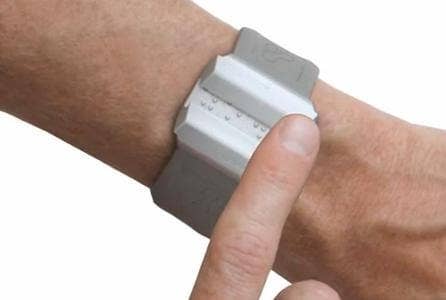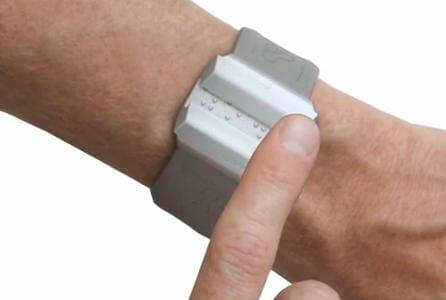Braille Watch to be Created Through Crowd-Sourced Funding (video)

Share
How do the blind tell time? You can help decide. David Chavez is a designer in California who has a great idea for a new kind of watch for the blind called Haptica. Current models come in two flavors: a classical watch face with bumps that a user compares to the position of the hands, or a talking watch with a digital voice. Neither is exactly ideal as Chavez explains in the video below. With his Haptica braille watch, he hopes to create a device that is easy to use, discreet, and accurate. There's just one catch: Chavez doesn't have the funds to create Haptica on his own. Through Kickstarter.org, Chavez is organizing a fund-raising campaign that will crowd-source the financing through online donations. Watch his pitch in the following clip and decide for yourself if Haptica is an idea you'd pay to make a reality.
https://www.kickstarter.com/swf/player.swf
Is it just me or is it ridiculous that it's 2011 and blind people are still walking around with sub-optimal time pieces? No offense to Chavez's sleek design but a silent watch with changing braille script seems like a no-brainer. In fact, he's not the only one to come up with this solution to the braille watch problem (here's a concept creation from Lawrence Kwok). Yet, as far as I can tell, no one has actually gone out and made one of these things available to consumers at large. That just seems absurd.
Which is why this project is on Kickstarter. For those of you unfamiliar with the site, it enables you to organize online fund-raising in a way that is clean, clear, and accountable. Users pledge real funds to the project via its webpage or an embeddable widget that can be cloned onto other websites. The project leader(s) establishes a fund-raising goal, posts a video calling for support, and does his/her best to draw attention to their project. If your call for crowd-funding goes viral you can generate hundreds of thousands of dollars. Yet there's a catch. If you don't raise enough funds to match your goal by a certain date, it all goes back to the people who pledged the money. In that way, Kickstarter guarantees that only those projects with a real-chance of success will actually draw funds from their considerably sized base of donors.
Kickstarter's formula allows almost anyone with passion and a sound business plan to find the charitable donations they need to get their idea funded. At the same time it acts as a sort of proving-ground for concepts. If you can't get donors to commit in such a low-risk forum, how could you survive in a traditional model of non-profit? When groups do succeed, as we've seen with do-it-yourself biology projects like Biocurious, it's a beautiful thing.
Be Part of the Future
Sign up to receive top stories about groundbreaking technologies and visionary thinkers from SingularityHub.


What are Haptica's chances? Hard to say at the moment. Their campaign ends on March 4th, and they are looking to raise $150,000. As of the writing of this post, Chavez currently has around $40,000. Now, many projects get a boost at they approach their deadline, but if you're worried they won't make it, go ahead and make a pledge. As with many Kickstarter projects, Haptica offers rewards to donors. Contribute more $250 or more and you'll get a first edition of the braille watch when it comes out, but even a $5 donation will get you a neat bracelet with braille script to help you practice.
The Haptica braille watch isn't the most innovative technology we've ever seen, but it's still pretty cool, and I think it's well over due for the blind to get such a device. Check out the project on Kickstarter and see if you aren't inspired to become part of their online support. From non-profit funding to real-world tricorders, we're all entering into the era of crowd-sourcing.
It's about time.
[screen capture and video credit: David Chavez]
Source: kickstarter, national design triennial
Related Articles

This Portable Wind Turbine Is the Size of a Water Bottle and Charges Devices in Under an Hour

Mojo Vision’s New Contact Lens Brings Seamless Augmented Reality a Step Closer
The Weird, the Wacky, the Just Plain Cool: Best of CES 2020
What we’re reading
